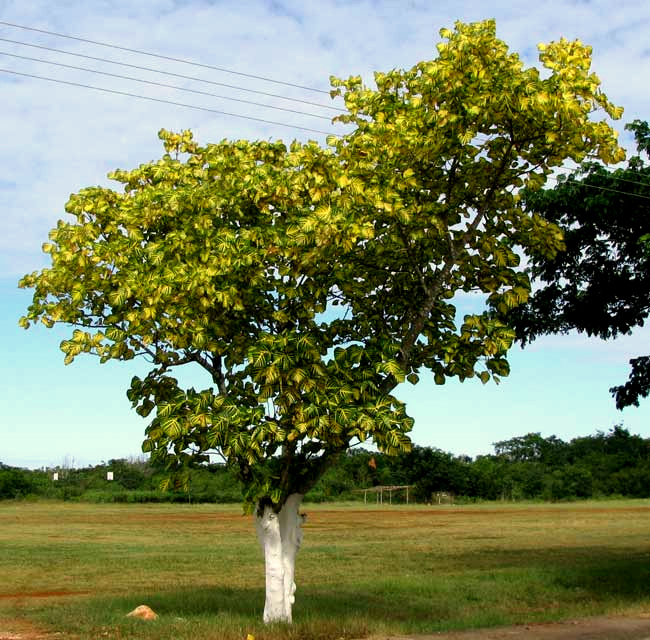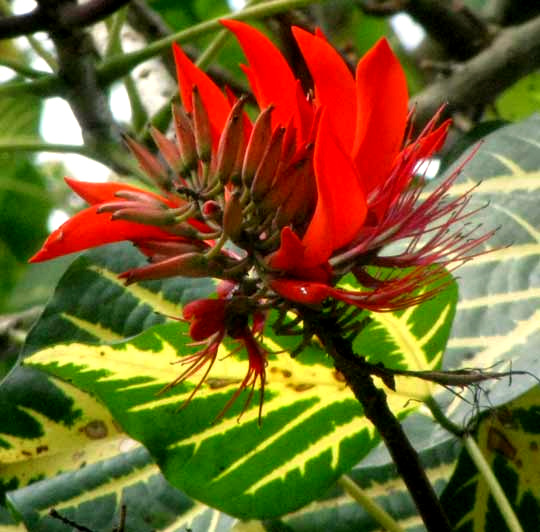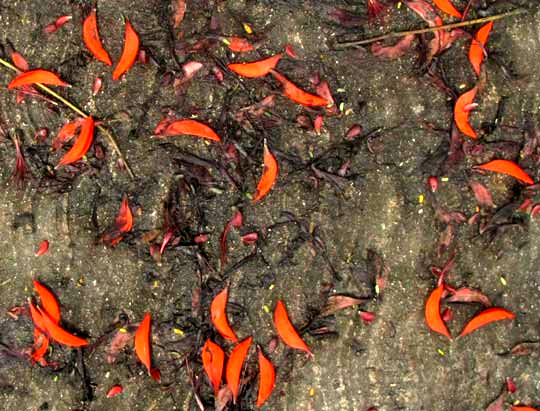Excerpts from Jim Conrad's
Naturalist Newsletter

from the November 14, 2010 Newsletter issued from Hacienda Chichen Resort beside Chichén Itzá Ruins, central Yucatán, MÉXICO; limestone bedrock, elevation ~39m (~128ft), ~N20.676°, ~W88.569°
INDIAN CORAL-TREE
On Pisté's north side, beside the soccer field and on the highway to the toll road between Mérida and Cancún, there stands the singular-looking tree shown above. Though I've seen this ornamental species planted throughout Mexico, I've put off introducing it here because I've been waiting for its flowers. However, somehow I've missed the flowers, despite their being described as brilliantly orange-red and forming spectacular inflorescences. A close-up of a cluster of the highly variegated leaves is shown below:

The leaves are trifoliate, like clover leaves. A single leaf with three leaflets at the end of a long petiole occupies the center of the last picture, though seeing it is like trying to make out a zebra in a closely packed herd of many zebras.
This is the Indian Coral Tree, ERYTHRINA VARIEGATA, so called because it's native to an area rom India to western China, and because species of the genus Erythrina generally are known as Coral-Trees. They're members of the Bean Family. In Querétaro we had a more typical, flowering coral-tree with easy-to-see leaves. You might enjoy comparing our current species with that at www.backyardnature.net/q/erythrin.htm.
Besides being pretty and easy-to-grow, in many cultures Indian Coral Trees are regarded as useful. In southern Florida they're often planted as hedges. In India they're used to support vine crops such as black pepper, vanilla, yam and betel. During the hottest months their leaves shade the vines, keeping them moist. When it gets cooler the leaves fall and the vines receive more direct sunlight, which is what they need at that time. Indian Coral Trees are popular shade trees in many places, and make excellent living fenceposts. Their leaves make good feed for most livestock, containing 16-18% crude protein.
In Asia, juice from the tree's leaves is mixed with honey to kill tapeworms, roundworms and threadworms. Women take the juice to stimulate lactation and menstruation. A warm poultice of its leaves relieves rheumatic joints. The bark is used as a laxative, diuretic and expectorant.
The Maya I've talked to don't seem to know about these uses, which is to be expected, since the species isn't a native American plant.
from the February 12, 2012 Newsletter issued from Hacienda Chichen Resort beside Chichén Itzá Ruins; limestone bedrock; elevation ~39m (~128ft), N20.675°, W88.569°; central Yucatán state, MÉXICO
INDIAN CORAL TREE FLOWERING
Above I said that I'd never seen one flowering. Now I have, on a tree in Pisté, as shown below:

Indian Coral Tree is a member of the Bean Family, so those 2½-inch-long flowers (8cm) are typical bean-type blossoms (papilionaceous), except that the top petal, the "standard" is much oversized relative to the lower petals -- the "wings" and "keel."
Below the photographed tree, discarded red standards are both messy and photogenic, as shown below:
